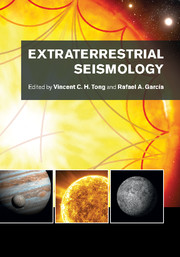Book contents
- Frontmatter
- Contents
- List of contributors
- Preface
- Acknowledgements
- List of abbreviations
- Planetary seismology: High risk, high return
- A bright outlook for helio- and asteroseismology
- Part I Observation and space missions
- Part II Data and physical parameters
- Part III Modeling approaches
- Part IV Discoveries of physical structures and processes
- Part V Interdisciplinary research involving planetary and astrophysical sciences
- Part VI Interdisciplinary research involving terrestrial seismology
- 24 The interpretation of seismic travel times
- 25 Interpreting cross-correlations in seismology
- 26 Waveform tomography in geophysics and helioseismology
- References
- Index
26 - Waveform tomography in geophysics and helioseismology
from Part VI - Interdisciplinary research involving terrestrial seismology
Published online by Cambridge University Press: 05 July 2015
- Frontmatter
- Contents
- List of contributors
- Preface
- Acknowledgements
- List of abbreviations
- Planetary seismology: High risk, high return
- A bright outlook for helio- and asteroseismology
- Part I Observation and space missions
- Part II Data and physical parameters
- Part III Modeling approaches
- Part IV Discoveries of physical structures and processes
- Part V Interdisciplinary research involving planetary and astrophysical sciences
- Part VI Interdisciplinary research involving terrestrial seismology
- 24 The interpretation of seismic travel times
- 25 Interpreting cross-correlations in seismology
- 26 Waveform tomography in geophysics and helioseismology
- References
- Index
Summary
What is waveform tomography?
Seismic tomography – in which we construct images of a body's interior using seismic waves – is an inverse problem; that is, our goal is to find a model that fits a set of existing data observations. This is much less straightforward than the reverse, forward problem (i.e., generating synthetic data from an existing model) due to the fact that multiple models can fit the same data or, in other words, the solution is non-unique. Furthermore, there may be parts of the model to which the data have no sensitivity, and small errors in the data can propagate into significant errors in the model (e.g., Trampert, 1998). In order to transform data space into model space, a seismic modeling algorithm is required that can generate synthetic data from an initial model, and then update the initial model to minimize the misfit between synthetic and observed data. There is therefore always a trade-off between the computational efficiency of the modeling algorithm and the accuracy or resolution with which it can represent the real seismic structure. Which kind of modeling algorithm is employed in a given situation depends very much on the nature of the structure being imaged, the quality of the data, and the available computational resources.
Traditionally, seismic tomography has used the travel times of wave phases between a seismic source and receiver to infer the sound-speed structure along the path between them. This so-called travel-time tomography, more typically referred to as “time–distance helioseismology” when applied to the Sun, is based upon ray theory, which assumes that waves travel with an infinitely high frequency, in much the same way as light rays propagating through a medium with smoothly varying refractive index, occasionally encountering a sharp interface. Under this approximation the seismic energy propagates along infinitesimally narrow geometric “ray paths.”
- Type
- Chapter
- Information
- Extraterrestrial Seismology , pp. 365 - 377Publisher: Cambridge University PressPrint publication year: 2015
- 2
- Cited by



